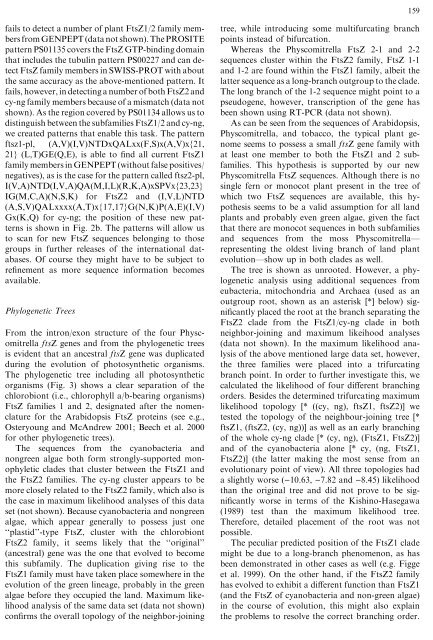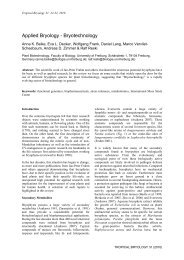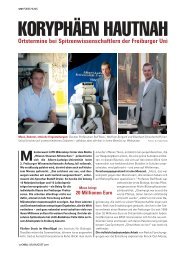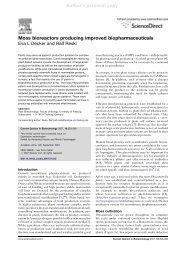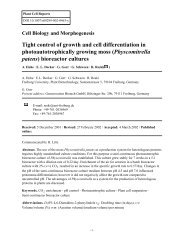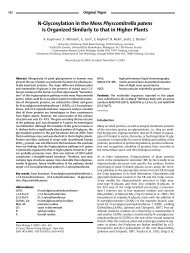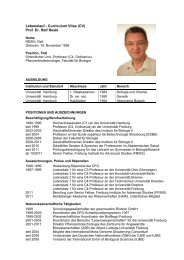Diversification of ftsZ During Early Land Plant Evolution
Diversification of ftsZ During Early Land Plant Evolution
Diversification of ftsZ During Early Land Plant Evolution
You also want an ePaper? Increase the reach of your titles
YUMPU automatically turns print PDFs into web optimized ePapers that Google loves.
159<br />
fails to detect a number <strong>of</strong> plant FtsZ1/2 family members<br />
from GENPEPT (data not shown). The PROSITE<br />
pattern PS01135 covers the FtsZ GTP-binding domain<br />
that includes the tubulin pattern PS00227 and can detect<br />
FtsZ family members in SWISS-PROT with about<br />
the same accuracy as the above-mentioned pattern. It<br />
fails, however, in detecting a number <strong>of</strong> both FtsZ2 and<br />
cy-ng family members because <strong>of</strong> a mismatch (data not<br />
shown). As the region covered by PS01134allows us to<br />
distinguish between the subfamilies FtsZ1/2 and cy-ng,<br />
we created patterns that enable this task. The pattern<br />
ftsz1-pl, (A,V)(I,V)NTDxQALxx(F,S)x(A,V)x{21,<br />
21} (L,T)GE(Q,E), is able to find all current FtsZ1<br />
family members in GENPEPT (without false positives/<br />
negatives), as is the case for the pattern called ftsz2-pl,<br />
I(V,A)NTD(I,V,A)QA(M,I,L)(R,K,A)xSPVx{23,23}<br />
IG(M,C,A)(N,S,K) for FtsZ2 and (I,V,L)NTD<br />
(A,S,V)QALxxxx(A,T)x{17,17}G(N,K)P(A,E)(I,V)<br />
Gx(K,Q) for cy-ng; the position <strong>of</strong> these new patterns<br />
is shown in Fig. 2b. The patterns will allow us<br />
to scan for new FtsZ sequences belonging to those<br />
groups in further releases <strong>of</strong> the international databases.<br />
Of course they might have to be subject to<br />
refinement as more sequence information becomes<br />
available.<br />
Phylogenetic Trees<br />
From the intron/exon structure <strong>of</strong> the four Physcomitrella<br />
<strong>ftsZ</strong> genes and from the phylogenetic trees<br />
is evident that an ancestral <strong>ftsZ</strong> gene was duplicated<br />
during the evolution <strong>of</strong> photosynthetic organisms.<br />
The phylogenetic tree including all photosynthetic<br />
organisms (Fig. 3) shows a clear separation <strong>of</strong> the<br />
chlorobiont (i.e., chlorophyll a/b-bearing organisms)<br />
FtsZ families 1 and 2, designated after the nomenclature<br />
for the Arabidopsis FtsZ proteins (see e.g.,<br />
Osteryoung and McAndrew 2001; Beech et al. 2000<br />
for other phylogenetic trees).<br />
The sequences from the cyanobacteria and<br />
nongreen algae both form strongly-supported monophyletic<br />
clades that cluster between the FtsZ1 and<br />
the FtsZ2 families. The cy-ng cluster appears to be<br />
more closely related to the FtsZ2 family, which also is<br />
the case in maximum likelihood analyses <strong>of</strong> this data<br />
set (not shown). Because cyanobacteria and nongreen<br />
algae, which appear generally to possess just one<br />
‘‘plastid’’-type FtsZ, cluster with the chlorobiont<br />
FtsZ2 family, it seems likely that the ‘‘original’’<br />
(ancestral) gene was the one that evolved to become<br />
this subfamily. The duplication giving rise to the<br />
FtsZ1 family must have taken place somewhere in the<br />
evolution <strong>of</strong> the green lineage, probably in the green<br />
algae before they occupied the land. Maximum likelihood<br />
analysis <strong>of</strong> the same data set (data not shown)<br />
confirms the overall topology <strong>of</strong> the neighbor-joining<br />
tree, while introducing some multifurcating branch<br />
points instead <strong>of</strong> bifurcation.<br />
Whereas the Physcomitrella FtsZ 2-1 and 2-2<br />
sequences cluster within the FtsZ2 family, FtsZ 1-1<br />
and 1-2 are found within the FtsZ1 family, albeit the<br />
latter sequence as a long-branch outgroup to the clade.<br />
The long branch <strong>of</strong> the 1-2 sequence might point to a<br />
pseudogene, however, transcription <strong>of</strong> the gene has<br />
been shown using RT-PCR (data not shown).<br />
As can be seen from the sequences <strong>of</strong> Arabidopsis,<br />
Physcomitrella, and tobacco, the typical plant genome<br />
seems to possess a small <strong>ftsZ</strong> gene family with<br />
at least one member to both the FtsZ1 and 2 subfamilies.<br />
This hypothesis is supported by our new<br />
Physcomitrella FtsZ sequences. Although there is no<br />
single fern or monocot plant present in the tree <strong>of</strong><br />
which two FtsZ sequences are available, this hypothesis<br />
seems to be a valid assumption for all land<br />
plants and probably even green algae, given the fact<br />
that there are monocot sequences in both subfamilies<br />
and sequences from the moss Physcomitrella—<br />
representing the oldest living branch <strong>of</strong> land plant<br />
evolution—show up in both clades as well.<br />
The tree is shown as unrooted. However, a phylogenetic<br />
analysis using additional sequences from<br />
eubacteria, mitochondria and Archaea (used as an<br />
outgroup root, shown as an asterisk [*] below) significantly<br />
placed the root at the branch separating the<br />
FtsZ2 clade from the FtsZ1/cy-ng clade in both<br />
neighbor-joining and maximum likeihood analyses<br />
(data not shown). In the maximum likelihood analysis<br />
<strong>of</strong> the above mentioned large data set, however,<br />
the three families were placed into a trifurcating<br />
branch point. In order to further investigate this, we<br />
calculated the likelihood <strong>of</strong> four different branching<br />
orders. Besides the determined trifurcating maximum<br />
likelihood topology [* ((cy, ng), <strong>ftsZ</strong>1, <strong>ftsZ</strong>2)] we<br />
tested the topology <strong>of</strong> the neighbour-joining tree [*<br />
<strong>ftsZ</strong>1, (<strong>ftsZ</strong>2, (cy, ng))] as well as an early branching<br />
<strong>of</strong> the whole cy-ng clade [* (cy, ng), (FtsZ1, FtsZ2)]<br />
and <strong>of</strong> the cyanobacteria alone [* cy, (ng, FtsZ1,<br />
FtsZ2)] (the latter making the most sense from an<br />
evolutionary point <strong>of</strong> view). All three topologies had<br />
a slightly worse ()10.63, )7.82 and )8.45) likelihood<br />
than the original tree and did not prove to be significantly<br />
worse in terms <strong>of</strong> the Kishino-Hasegawa<br />
(1989) test than the maximum likelihood tree.<br />
Therefore, detailed placement <strong>of</strong> the root was not<br />
possible.<br />
The peculiar predicted position <strong>of</strong> the FtsZ1 clade<br />
might be due to a long-branch phenomenon, as has<br />
been demonstrated in other cases as well (e.g. Figge<br />
et al. 1999). On the other hand, if the FtsZ2 family<br />
has evolved to exhibit a different function than FtsZ1<br />
(and the FtsZ <strong>of</strong> cyanobacteria and non-green algae)<br />
in the course <strong>of</strong> evolution, this might also explain<br />
the problems to resolve the correct branching order.


